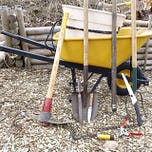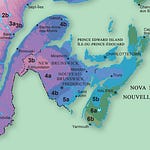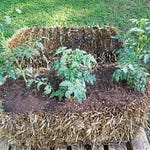Getting Started, Part 3 - Gearing Up with the Right Tools
Garden tools allow you to do four basic tasks: dig soil, move soil, spread soil, and cut things. Your set of tools should allow you to do all of these things, but depending on the size and scale of your garden, you don't need to break the bank to get started, and you may not need all of them.
Here are all the basic tools that I use for gardening. The knife, bucket and ho mi digger are used most often.
I am always amazed at the multitude of useless tools that I see for sale at garden centers. Horticulture is thousands of years old, and while certain tools do make the job easier, in a pinch, you could get by like our ancient ancestors with a basket, a pointed stick and your bare hands. This week's column is a no-nonsense discussion of the basic tools needed to start gardening, and will complete the three-part Getting Started series that I began a couple weeks ago.
Light Diggers
The cheapest digging tool in the world is your hands and they are extremely versatile. I would say that at least half the cultivation that takes place in my garden is probably done with my hands. A couple of cheap pairs of dollar store gloves are all you need here. A step up would be a digging tool, and while I see many forks and scoops and other useless junk, for my money the "ho mi digger" is the king. This simple Bronze Age tool is the only digging tool you will ever need. Indeed, if I were going on a spaceship to colonize another planet and I could only bring one tool, it would be this one.
Heavy Diggers
One round-nosed shovel is all the shovel you will ever need in a food garden. Find one with a long handle so you don't have to bend over all the time and don't waste your money on the square-ended types. They are simply harder to use and less versatile. To make your shovel work even better, keep the front edge sharpened. For some reason they are never sold this way, so pick up a file when you are at the hardware store. All my shovels were the cheapest ones available when I bought them and they all still work great.
If you need to break up the ground, a pickaxe will make short work of even the most compacted soils. They are also useful for prying up buried rocks, logs, etc. I have never used a rototiller in my garden - the pickaxe was all I even needed to claim the rocky and weedy 2,500-square-foot area where my garden now resides. That said, if you have a lot of area to cover, it does makes sense when breaking new ground. A garden fork or pitchfork can also be useful for loosening up ground, although it's not as effective as a pickaxe if the ground is really hard. On the good side, a pitchfork is great for moving hay, manure and mulches and is easier to use than a shovel for these tasks. Movers
In a garden, you will need a means to move materials around. If money is tight, buy a tough plastic container. If you tie a rope to it, you can drag it across the ground, and in many ways it is more versatile than a wheelbarrow. If price is no option, buy an all-steel wheelbarrow — it will last you a lifetime if you treat it right. I have two wheelbarrows: the one with the wooden handles has had them replaced twice and I've also replaced its wheel. The all-steel contractor-grade wheelbarrow is as good as the day I bought it. Despite having two good wheelbarrows, I always have at least one or two laundry-basket-sized containers kicking around in the garden, and I use them all the time.
Spreaders
Whether you are working with compost, manure or mulches, a garden rake makes short work of big jobs where area and volume are in the mix. Again, I don't think it's worth spending much here. The rake that I use most of the time (in picture) was fished out of a trash can years ago, and despite some minor repairs, is still going strong.
Cutters
A cheap dollar store utility knife or a sharp old kitchen knife are adequate for almost every cutting task required in a vegetable garden. If, however, you plan to have berry bushes and/or fruit trees in your garden, then you will eventually need pruning shears and a pruning saw. This is one of the few places where I would advise strongly against going cheap. I use a Felco #8 bypass pruner, and Silky Gomboy (210-mm blade) with extra-fine teeth. Each of these are in the $50 range, but if properly cared for will last many years, if not a lifetime. Switching from the cheap garbage that I had before these tools was like going from a butter knife to a light sabre.
Final thoughts
So that's the basic gear you will need for gardening, and these are all I ever use in my gardening. Not all of these tools are essential, but in order to make gardening as cost effective and energy efficient as possible, they all play a role. I am fully confident that with a ho mi digger, a knife and a bucket, I could probably build and maintain a garden large enough to feed my family given enough time — but I would miss the other specialized tools. One final note on the topic of tools: remember, this column is about permaculture gardening, where annual tilling is absolutely unnecessary; so any heavy work is a one-time deal, and generally speaking, all the heavy work is minimal and infrequent. There are no heavy expensive tillers, etc. on this list, because permaculture gardens are low maintenance by design.
Subscribe to get full access to the newsletter and website and to leave comments. One new article a week. Never miss an update. $5 a month, $30 a year.














